Daymare Town ornament
October 25, 2024
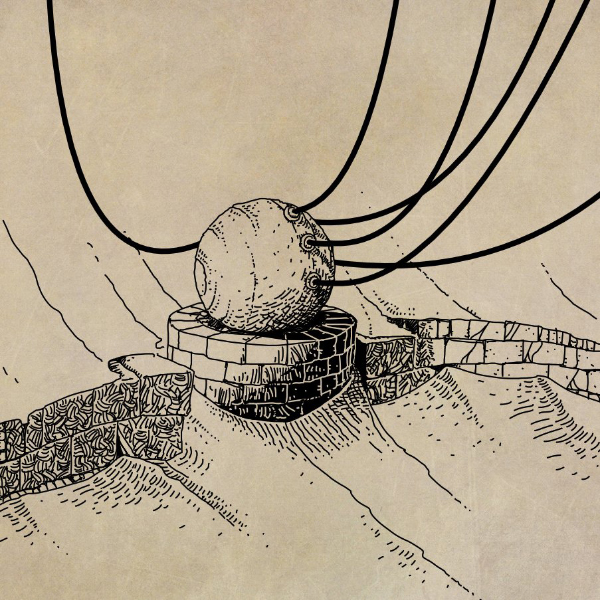
 Mówi się, że każdy człowiek ma swoje dobre i złe strony – swoją jasną oraz ciemną osobowość. Z pewnością każdy ma także w sobie nieco Blakiego, choć jest on trochę jak smutna piosenka, której słuchamy dla przyjemności. I dlatego, że czujemy się jak bohaterowie, o których śpiewa wokalista.
Mówi się, że każdy człowiek ma swoje dobre i złe strony – swoją jasną oraz ciemną osobowość. Z pewnością każdy ma także w sobie nieco Blakiego, choć jest on trochę jak smutna piosenka, której słuchamy dla przyjemności. I dlatego, że czujemy się jak bohaterowie, o których śpiewa wokalista.
Ostatni Blaki to piąty i podobno finalny tom serii o tytułowej postaci, którego autorem oraz rysownikiem jest Mateusz Skutnik. O pierwszej części pisałam przy okazji jej wznowienia kilka lat temu.
Najnowszy tom można jednak traktować jako indywidualne, oderwane od całości dzieło. Twórca sam nawet radzi, żeby to właśnie Ostatni Blaki stał się tym pierwszym komiksem w konfrontacji z bohaterem, jeżeli jeszcze nie mieliście okazji się poznać.
Świat Blakiego też ma kolory.
Znajdziecie w nim wszystko, co znane jest człowiekowi dorosłemu. Są pociągi, narzekanie na deszcz i zarazem pochwała melancholii, którą ten ze sobą niesie. Jest przemijanie życia, troska oraz zataczający się krąg, który dotyka każdego rodzica i każde dziecko.
W Ostatnim Blakim jest tacierzyństwo, czyli coś w czym nie powinno być czerni i melancholii, ale który to stan przemija niezwykle szybko, pozostawiając ludzi jeszcze bardziej melancholijnymi oraz prawie do niczego nieprzydatnymi. Dzięki jednak tacierzyństwie – czy tym pojedynczym momentom życia, świat Blakiego nabiera kolorów.
Potrzeba mówienia i nazywania życia.
Gdyby Blaki miał konto w mediach społecznościowych, jego wpisy wyglądałyby dokładnie tak, jak przedstawia autor te pojedyncze sceny, które składają się płynnie w jedną całość. I miałby pod nimi mnóstwo polubień, bo Blaki mówi o tym, co dotyczy każdego z nas. Inna sprawa jest taka, że do Blakiego wcale nie pasuje ani Instagram ani Facebook.
Jest on trochę ponadczasowy. Jego proste rozważania urastają często rangą do filozoficznych refleksji. Autobiograficzne wstawki urzeczywistniają Blakiego, a jego potrzeba mówienia i nazywania życia wydaje się przeczyć pozornej idei powstania cyklu. Można bowiem wysnuć przypuszczenia, że Ostatni Blaki to komiks o cieszeniu się codziennością.
Polecam tę wzruszającą, zabawną, charyzmatyczną książkę odbiorcom powyżej 16 lat. To lektura do której się wraca.
 Blaki w jednej z ostatnich scen mówi, że chyba najwyższy czas zamilknąć. I ja pójdę za jego przykładem, ale za chwilę. Najpierw napiszę, że Ostatni Blaki to jedna z najcudowniejszych rzeczy jakie miałem w tym roku w rękach.
Blaki w jednej z ostatnich scen mówi, że chyba najwyższy czas zamilknąć. I ja pójdę za jego przykładem, ale za chwilę. Najpierw napiszę, że Ostatni Blaki to jedna z najcudowniejszych rzeczy jakie miałem w tym roku w rękach.
Nostalgiczny, atmosferą przypominający deszczowy listopadowy poranek, zanurzony w melancholii i próbie zrozumienia przemijającego czasu, pełen trafnych spostrzeżeń i… wesoło/smutny.
Wystarczy spojrzeć na Blakiego siedzącego nad brzegiem jeziora lub zatrzymać wzrok na Blakim patrzącym w morze i już wiesz, już jesteś tam, gdzie trzeba. Mógłbym czytać i oglądać to całą dobę, zabrałbym na bezludną wyspę. Więcej niż konieczność.
 Nowy “Blaki” wyśmienity. Powrót Mateusza po kilku latach przerwy, cieszy mnie nie mniej, niż powrót “Produktu”. To pierwszy “Blaki” w kolorze i od razu te kolory też grają swoją rolę i robią fantastyczną robotę. Cała oprawa graficzna jak zwykle u Skutnika jest pierwsza klasa, ale pokusiłbym się o stwierdzenie, że przerwa od komiksu wcale nie stępiła temu twórcy pędzelków, a wręcz przeciwnie – czuję tu głód i radość z powrotu.
Nowy “Blaki” wyśmienity. Powrót Mateusza po kilku latach przerwy, cieszy mnie nie mniej, niż powrót “Produktu”. To pierwszy “Blaki” w kolorze i od razu te kolory też grają swoją rolę i robią fantastyczną robotę. Cała oprawa graficzna jak zwykle u Skutnika jest pierwsza klasa, ale pokusiłbym się o stwierdzenie, że przerwa od komiksu wcale nie stępiła temu twórcy pędzelków, a wręcz przeciwnie – czuję tu głód i radość z powrotu.
Fabuła niby typowa dla komiksów o tym bohaterze, ale też tym razem jest inaczej. Wątki sprawnie się przeplatają, momentami jest bardzo onirycznie, momentami zabawnie i oczywiście refleksyjnie. Motywy z babcią czy dziećmi są autentycznie wzruszające, a pudełka po lodach? No kurde! Z tym utożsami się chyba niemal każdy. Gorąco polecam. Mi lektura sprawiła dużo radości i o razu zapragnąłem zrobić sobie powtórkę z wszystkich albumów. Na szczęście są na półce.
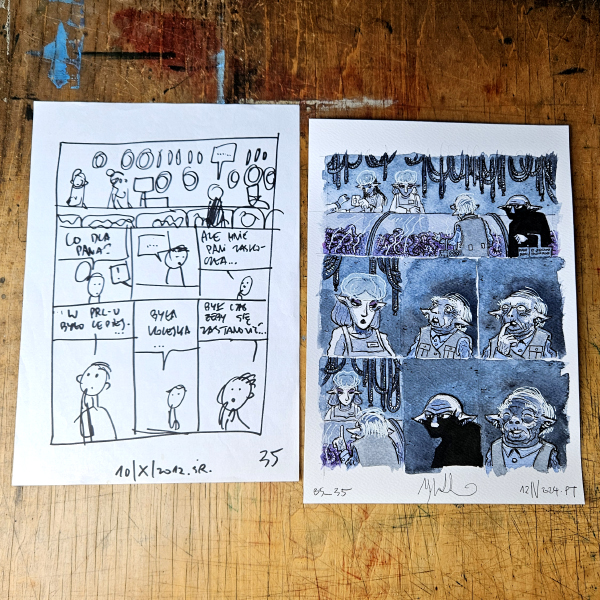
Szkic tej strony powstał w 2012 roku. Czyli jeszcze przed ukazaniem się poprzedniego albumu dziesięć lat temu. Pewnie nie pasowała nigdzie i została odłożona na później.
Na później, czyli na teraz. Finalna strona powstała w 2024 i znalazła się w sekcji przygód sklepowych w Ostatnim Blakim.
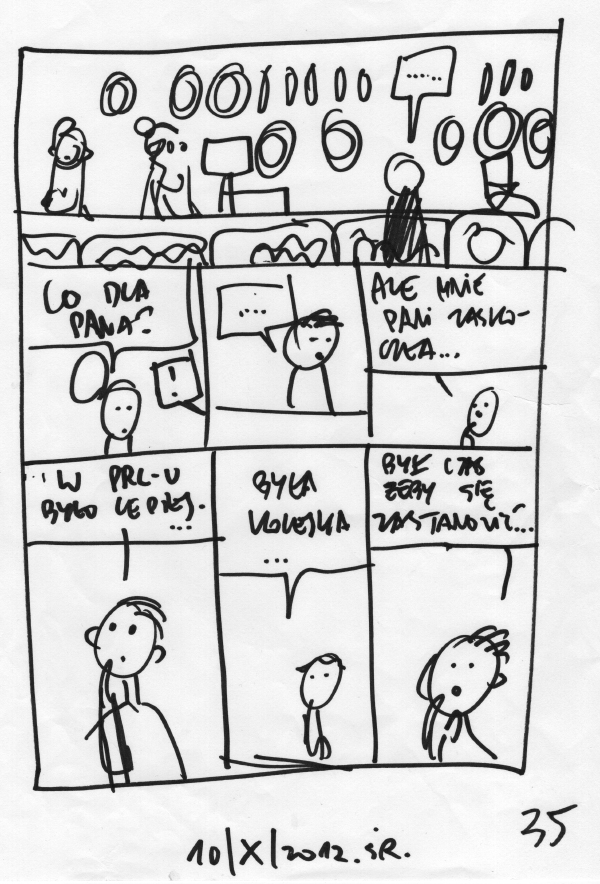
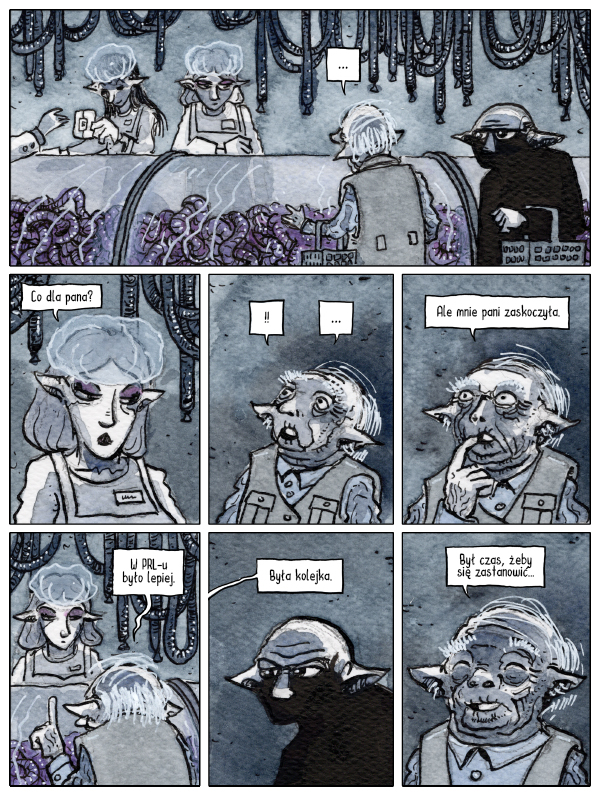
i takiej coca coli
już nigdy.
Parafrazuję tego pana Marcina w tytule, ale chyba nikt nawet nie skojarzy skąd i co, więc w zasadzie po co? A bo mi przyszedł do głowy ten cyctat i jakoś tak w klimacie Blakiego mi siedzi.
No bo byłem w Łodzi, na festiwalu komiksów i gier i tam kupiłem sobie komiks. Komiks, który zresztą planowałem tam kupić, bo miał tam, też swoją premierę i w zasadzie jest to główny powód, dla którego tam jechałem. No i na spotkanie z autorem, na którym ostatecznie nie byłem.
Ostatni Blaki, najnowszy komiks Mateusz Skutnika, sądząc po treści może być rzeczywiście ostatnim komiksem o Blakim. Ale jestem też w stanie sobie wyobrazić sytuację, w której otwieram kiedyś w przyszłości nowy album, w którym w pierwszych kadrach Blaki tłumaczy, że żartował i ma jednak dla nas kilka nowych historii. Bo taki jest Blaki i taki jest ten komiks. I może się okazać, że zarówno autor, jak i Blaki mają jeszcze coś do dodania. Tymczasem ja nie dotarłem w końcu na to spotkanie, bo musiałem wcześniej wyjechać z Łodzi i jedyne czym musiałem się zadowolić to trzy zamieniona słowa w biegu na korytarzu przed stoiskiem Timoffa. I jak czytam teraz ten komiks to widzę Blakiego dokładnie w takiej sytuacji z tym komiksem bez autografu. Jak zwykle. Dobrze, że chociaż nie pada.
No dobra, ale o czym to jest.
O Blakim przecież. W serii o rewolucjach Skutnik buduje skomplikowane światy i rozgrywa fantastyczne historie. W serii o Blakim stawia po części siebie, albo jaką część siebie, w zupełnie normalnym, zszarzałym już, prozaicznym świecie. I trzeba tu powiedzieć, że ten komiks mógł polec na bardzo wielu frontach, Blaki porusza się po bardzo kruchym lodzie i stąpa po czerwonej linii, którą jeśli przekroczy, to stanie się boomerskim marudą lub nawet zrzędliwym dziadem. Ale Skutnik nie przekracza tej linii i dzięki dystansowi i dowcipowi tworzy postać, w której mnóstwo moich rówieśników odnajdzie własne odbicie. Czy jest to zatem komiks tylko dla moich rówieśników? Nie wiem, może zmuszę dzieci do czytania, to napiszę.
Fragmenty, które szczególnie mnie ujęły to historia z kluczem, wraz z jej niebanalnym rozwiązaniem oraz to, co robi autor z Blakim, kiedy ten spotyka babcię. Całe misterium tego, co dzieje się podczas tego spotkania i po nim ma w sobie tyle magii, że nagle cała postać Blakiego (nie tylko z tego komiksu ale w ogóle) jest odbierana inaczej.
No ale żeby nie było, smutny jest to komiks, pełen nostalgii i trochę zmęczenia. Może też dlatego, że ma być ostatnim. Mimo wszystko jednak nie mogę oprzeć się wrażeniu, że przyjdzie wiosna i Blaki wynurzy się, żeby ogłosić, że jednak nie umarł i ćmi go w zębie brakuje mu guzika u koszuli.
Komiks wydał Timof i jest on do kupienia właśnie u niego oraz na gildii. Polecam bardzo. Jednocześnie czekam na zapowiedzianą i fundowaną karciankę w świecie submaszyny, ale to dopiero w styczniu jakoś.
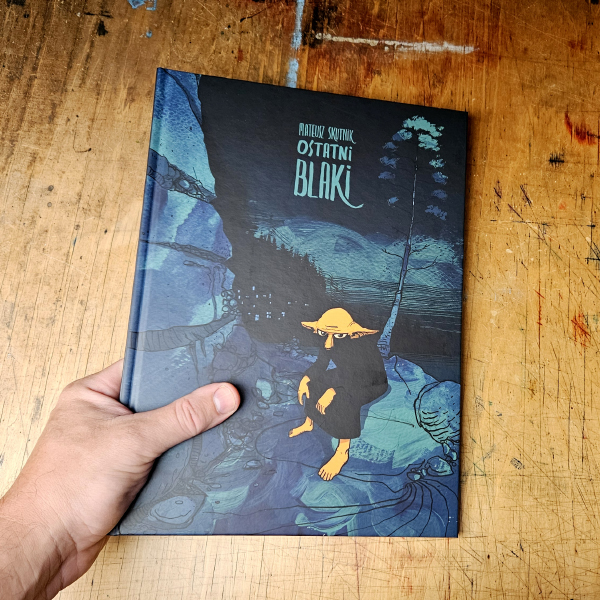
 Najbardziej wyczekiwana komiksowa premiera tegorocznego MFKiG poszła na pierwszy ogień (już wczoraj zresztą).
Najbardziej wyczekiwana komiksowa premiera tegorocznego MFKiG poszła na pierwszy ogień (już wczoraj zresztą).
“Ostatni Blaki”.
Jestem psychofanem Blakiego od pierwszego, skromnego zeszyciku z 2005 roku. Bo (sorry, “Produkt”, with all due respect) to właśnie ten tomik przekonał mnie do polskiego komiksu pokazując, jak można mądrze opowiadać o codzienności, mieszać liryzm z cynizmem, a pozornie trywialne i drobne obserwacje podnosić do rangi filozoficznych rozkmin.
“Myślenie Blakim” okazało mi się niesamowicie bliskie i takim zostało. Zresztą – chyba bliskie jest każdemu, bo ten bohater to everyman i jego zawieszone w powszedniości pytania są tak oczywiste, że nie wiem.
Mateusz powiedział na spotkaniu autorskim, że formuła się wyczerpała, Blaki się ustatkował i nie ma żadnych wartych opisania przygód.
Nie wierzę.
Bo Blaki robi przygodę z przekręcenia dwa razy klucza w zamku albo z niezabrania z domu parasola.
To najdojrzalsza, najlepsza odsłona. Można ją spokojnie poznać bez znajomości poprzednich części. Kupujcie “Ostatniego Blakiego”. Będzie warto, jeśli rzeczywiście będzie ostatnim, ale będzie też warto, jeśli stanie się dla Was pierwszym.
Blaki nie lubi dużych słów, ale piszę to ja. I jestem zachwycony.
kup ten komiks / buy this book
sample pages | trailer | unboxing
na co patrzy Blaki? | ciekawostka scenariuszowa
Po dziesięciu latach Blaki powraca! Nie do pomyślenia, ale w międzyczasie rzeczywiście dziesięć lat przeleciało… Czy jest sens jeszcze do tej serii powracać po tak długiej przerwie? Cóż, wszyscy jesteśmy starsi, świat jest inny, okoliczności są inne, tylko Blaki ten sam. To jak te stare kapcie, te najwygodniejsze.
64 strony komiksowe, tym razem w kolorze (przygaszonym, stonowanym, ale zawsze).
~
Recenzje:
~
detale wydawnicze:
Ostatni Blaki
Autor: Mateusz Skutnik
Wydawca: Timof i cisi wspólnicy
Cena: 60 zł
ISBN: 978-83-67440-98-1
Format: 210×290
Oprawa: twarda
Liczba stron: 68
Druk/barwność: kolorowy
Zalecane dla odbiorcy: Młodzież i dorośli
Komiks nr 460
Wydanie: I
Data wydania: 16 września 2024
~
Teraz mogę już powiedzieć, że jest to jednocześnie najlepszy i najważniejszy album komiksowy w moim życiu. Nosiłem go w głowie przez ostatnie pięć lat nie wiedząc, czy uda mi się go kiedykolwiek zrobić. Fakt, że teraz mogę go przekazać w wasze ręce jest dla mnie bardzo ważny. Czy trzeba znać poprzednie tomy, by ten miał sens? Nie. To samodzielny album. Jeżeli nigdy nie czytaliście Skutnika a być może chcielibyście spróbować, to to jest ten album, od którego bym proponował zacząć.
25.IX.2024
 Pogodził się z własnym losem? Ostatnie myśli Blakiego.
Pogodził się z własnym losem? Ostatnie myśli Blakiego.
Kiedy Blaki, główny bohater komiksu Mateusza Skutnika, po wymierzeniu ostrej krytyki w facetów, którzy chodzą z parasolami stwierdza, że bardziej upokarzające jest chyba tylko biegnięcie na tramwaj i pyta, „czy nie można przyjąć swojego losu na spokojnie i z godnością”, to ja przypominam sobie, że to również moje motto. Czasami, kiedy wracając z pracy widzę nadjeżdżający 159 i jestem od trajtka o szybki sprint, mówię sobie w myślach „po co będziesz biegł? Nie wygłupiaj się i pogódź z własnym losem”.
Nie biegnę, godzę się, czekam na następny.
A kto mnie tego nauczył? Otóż ta dewiza zalęgła mi się w głowie po przeczytaniu któregoś z wcześniejszych tomów Blakiego – chciałem nawet sprawdzić którego, ale ten komiks miał tyle formatów, tylu wydawców i tyle razy już się kończył i zaczynał, że zrezygnowałem z poszukiwań. Zakładam, że skoro ta sentencja towarzyszyła mi przez wiele lat, to pamiętam ją dość dobrze. Czy jednak to małe deja vu podczas lektury Ostatniego Blakiego (wyd. timof comics) to oznaka tego, że Mateusz Skutnik teraz, na sam koniec, zaczyna się powtarzać?
Blaki to specyficzna postać, która już wcześniej wspominała, że nie ma nic więcej do powiedzenia. A później wracała i gadała dalej. To taki bohater filmów Koterskiego, tylko niedookreślony gatunkowo – Blaki nie jest człowiekiem, a takim yodopodobnym ludzikiem, który ciągle narzeka i wyraża swoje zdanie na każdy temat. Lub raczej wyrażał. Bo w tym tomie coraz częściej powątpiewa i milknie. Blakiego spotykamy tym razem na etapie codzienności, którą dzieli ze swoją rodziną – ta codzienność bywa zabawna i wzruszająca.
Blaki od dawna nie jest już samotnikiem, którego przygody polegały na patrzeniu się na pranie. To bohater, który jest już w takim wieku, że coraz częściej podaje w wątpliwość swoją przydatność dla świata; który ma swoje lęki i którego życie nabiera pięknych kolorów tylko wtedy, kiedy w sklepie, zupełnym przypadkiem, dopadną go zapachy przeszłości. Blaki wie już wszystko. Jest na granicy. Kiedyś jego myśli wypełniały całe strony pięknie zarysowanych plansz, teraz – czas na reset. Na ciszę znaczącą więcej niż milion słów.
Też liczysz schody, jak wchodzisz na swoje piętro? Wychodząc z mieszkania przekręcasz klucz w zamku dwa razy? Masz czasem ochotę wyrzucić te przeklęte pudełka po lodach przez okno? Jeśli tak, to Ostatni Blaki jest komiksem dla Ciebie.
Chciałem jeszcze powiedzieć, że ta piękna tragikomedia po 23 latach dobiegła końca w sposób godny, ale nie zdążę. Spieszę się na trajtka. Nie planuję biec. Ale też nie sądzę, żeby na mnie zaczekał.